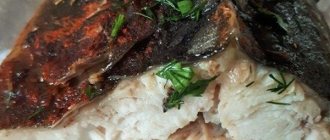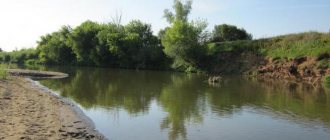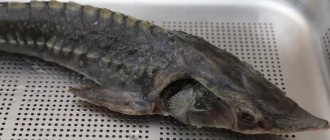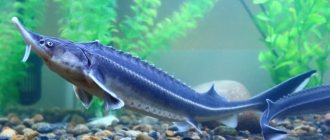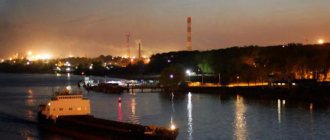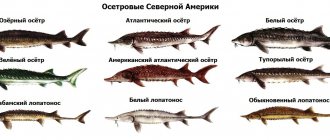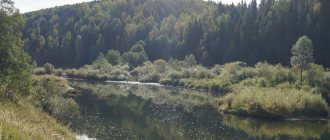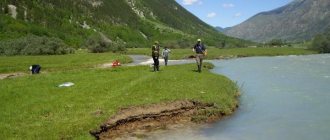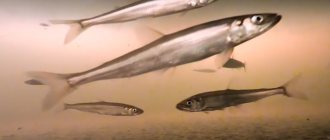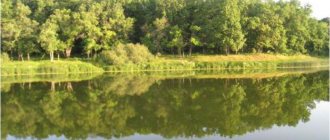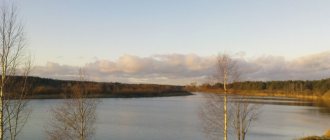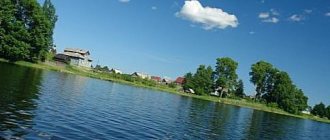general description
The Sturgeon River is 228 kilometers long. The area of its water surface is 3480 square meters. km. The river reaches its maximum width in various artificial extensions (there are 10 of them). There are 2 of the largest ones. “Seas” 400 m wide have been created on 3 sections of the channel. Such surprises begin from Burakovo. And the predominant width values are 50-85 m. Depths in the upper reaches do not exceed 1.5, in the lower reaches the parameter can reach 2.5 meters. Water flow in the reservoir is 13.3 cubic meters per second. The food is exclusively snow.
The channel crosses 3 regions - Tula, Ryazan and Moscow regions. The water flow belongs to the Oka basin, connecting with it already at the exit from the Central Russian Upland to the Moskvoretsko-Oka Plain (between Zaraisk and Kolomna). Forest floodplain is present in only a few areas.
Speaking of geology, the Sturgeon River appeared during the formation of the final “touches” of the Central Russian Upland. In the 9th century this is the area within which the Finnish people Meshchera, the Vyatichi Slavs and the Baltic Golyad tribe shared the land. But they were only guests on the southern outskirts of the middle Oka. The fact is that until the 3rd century. Late Scythian clans lived here. Their settlements were stormed and burned by the first Baltic tribes (the ancestors of the chronicle golyad). The first description of the Sturgeon River is contained in Russian folk legends. Our ancestors believed that sturgeon came here from the Volga (via the Oka). That’s why this “artery” got its name. There were also many “horror stories” about this hydrological object. Like, Sturgeon constantly takes people away. The river route actually passes through dangerous pools. We are talking about “suction” pits 3-5 meters deep. According to the Nikon Chronicle, which tells about the events of the mid-12th century, the Sturgeon River is located in the center of the western defensive line of the Ryazan principality. One of these strategic fortifications on the border with the restless Chernigov state is the town of Zaraysk. In the era of its appearance (since 1146), it itself was called in honor of the reservoir - Sturgeon. On a river branch called Mordves, Soviet troops (during the Tula defensive operation) pushed back the Nazis' 2nd Tank Army to the west.
The use of the Sturgeon River has never been associated with shipping. But in Soviet times it was artificially expanded in the area of the largest agricultural agglomerations. For pumping water to irrigate fields. This is still happening on 10 fragments. And in Serebryanye Prudy, Osetra water fills 10 square tanks.
Source and mouth of the Sturgeon River
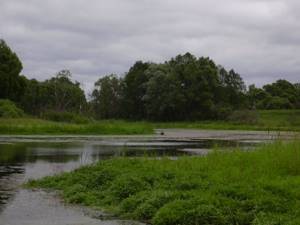
The source of the Sturgeon River lies on the Central Russian Upland. Near the small village of Melekhovka, Tula region. The location's landmarks are 2 quarries filled with water. It was in them that moisture from small rivers collected, feeding the source of the Sturgeon River. He himself can be seen at the edge of the forest. In front of a large birch grove. This is a pond.
The mouth of the Sturgeon River is located in the Ozyory urban district (metropolitan region). Opposite the 85 m wide arm is Akatevo - the entire “border” between Ozery and Kolomna. The character of this sloping coast is a sandy stretch with cattails on the edge. The mouth of the Sturgeon River is a reservation that other local residents use as a swimming pool.
Cunning Rival
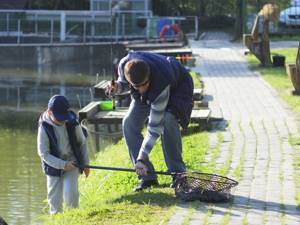
“It’s very interesting to catch sturgeon,” admits Nikita Smirnov, administrator of the Fishka fishing club in the Ruza urban district. “He doesn’t just give up, you have to fight him.” A sturgeon can easily eat the bait and escape or get off the hook.
Despite the fact that sturgeon is literally the most expensive trophy for paid fishing visitors, some come to the reservoir specifically for this fish. Sturgeons prefer to be under the water column, so special fishing gear is used to catch them, which allows the bait to be placed at the bottom of the reservoir. Herring, smoked or canned, is often used. The bait must be “fragrant”: the sturgeon finds it by smell.
The royal fish is also distinguished by its vitality. For example, after lying on the ice for several hours, a sturgeon can easily “wake up” later. Also, falling off the hook is not as dangerous for him as for other fish.
Basin of the Sturgeon River
In the Yasnogorsk region, the Osetr River passes through a spacious birch grove, in the second half of which (near Burakovo) it forms its first reservoir. In the Venevsky district, up to Anishino, it whimsically meanders due south. Its “body” again becomes no wider than 40 meters. Another expansion is taking place in the said settlement, but it is minor. The banks on both sides are slightly steep. Leaving the forest zone, the reservoir begins to make a loop, turning to the north. In the Osetrovskoye forestry (thickets of birch, alder, linden, aspen, ash) it expands to 67 meters and rushes a little to the east. By the way, tall spruce trees were planted at the Golden Sturgeon camp site. Subsequently, the flow of the Sturgeon River passes the agricultural plain, and in the area of the intersection with the toll branch of the M-4 highway, it absorbs the first (most full-flowing) tributary - Verkusha. This is the land of the private sector of Makhrinka. It is here that the channel widens for the second time (after Burakovo) to 400 meters! The next significant branch, Venevka, takes in the basin of the Sturgeon River north of Venev. Later, the flow of the Sturgeon River goes east, taking water from Mordves (the village of Novomoygory), and then again to the northeast, remaining narrow. At the same time, it turns out to be already within the borders of the Moscow region. Even single trees end here, passing the baton to the bushes. And the coast becomes more flat.
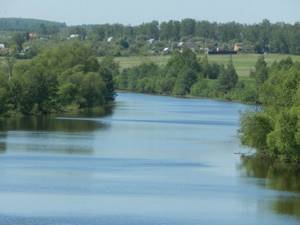
In the vicinity of Serebryanye Prudy, the Osetr River basin was partially dissolved into many reservoirs (ponds and canals). Here the river meanders south, then again moves northeast, through the fields. For some time it accompanies the Serebryannye Prudy–Zakharovo highway (laid on an embankment). Here the reservoir is already on the plain, no longer leaving it. It affects the territories of two districts of the Ryazan region, again touching the thicket. Near the village of Livadia on the right bank there is a dense aspen-alder forest. We emphasize that from Serebryanye Prudy to Livadia the channel is already 70 m long.
The “second Moscow” course of the Sturgeon River begins at the treeless Zheleznitsky settlements, passing by the Loshatovka railway platform and 5 villages. It is here that the departure to the north and the formation of large and small bows begins, the wooded ones of which are Peskovskaya, Tregubinskaya and Strupenskaya. These are birch groves surrounded by small villages... Later, the water traveler ends up in Zaraysk, where the river valley again expands to 70 meters. In the area of the bridge there is the Zaraisky Kremlin.
The lower reaches of the water stream are a natural park on its left (interfluve with the Oka) and right (Big Forest) banks. And they are described in detail in the “Attractions” section.
Sights of the Sturgeon River

Melehovka tract
The Sturgeon River begins its journey from here, a couple of kilometers from the village of the same name. The distance from Tula is 29 km. From the mentioned regional center, it’s faster to drive here first along M-2, then turn onto the Yasnogorskaya road, in the Shemetovo area go right, onto the “asphalt road” to the former Gigant state farm. It doesn't take long to get through the primer. The tract resembles an elongated lake. Many streams run here. On the northern shore there is a beautiful deciduous grove. In the south there is a brightly flowering meadow. There is rich undergrowth at the edge.
Reservoir near Burakovo
The Sturgeon River forms the first water reservoir on its route here. There is a dense birch grove around. Near the water there are willows and low-growing alders. A camp site was built nearby (in the northeast corner). She occupied the only beach-like area. The dam limits the water area from the east. There is asphalt along it to the highway to Gorshkovo.
Venev Monastery in Osetrovskoe forestry
If you decide to go on a difficult rafting trip along the Sturgeon River right from the Burakovskaya Dam, then the first point of the excursion will be waiting for you in the next forest belt. On the territory of the Osetrovskoye forestry there is the Venev Monastery, the first building of which appeared here in the 11th century. Now the building has a pinkish tint. The reconstruction tried to preserve the original appearance of the religious building. Women's monastery, active. Behind the Beryozka base and Epiphany you will see the green domes of this ensemble. He's nearby.
Church of the Virgin Mary
As you guessed, the Sturgeon River is located in the formation zone of the main ancient Russian principalities, and therefore there is plenty of ancient buildings here... The temple mentioned in the title will be found just five kilometers of the waterway from the point just described. The date of his “birth” is the first half of the 18th century. Not reconstructed. The ruins are overgrown with undergrowth. But you can see the architectural masterpiece from Sovkhoznaya Street in the village of Milenshino, on the territory of which this Orthodox complex stands.
Manor von Mecca
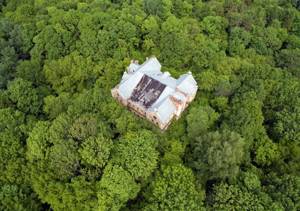
Walking along Khruslovka, the Osetr River separates the residential part of this settlement (orphanage) from the estate of Maximilian Mecca, a famous railway engineer in Russia. He lived and worked at the end of the century before last - the beginning of the last century. The estate was built by his mother in the 1880s. The palace was built in the Romanesque style and housed 24 rooms. At the moment it is a remnant. But the “box” itself is not damaged. The yard also contained outbuildings. Only one of them has survived. Here you will come across a mysterious-looking tomb, the entrance to which is terribly overgrown with weeds.
Silver Ponds
In the first Moscow fragment, the Osetr River makes a deep bend to the south. At the edge of the loop are the neighborhoods of the beautiful town of Serebryanye Prudy. Ponds, after which the residential areas were named, are present in large numbers. They are different sizes. Among the historical attractions are the Znamenskaya Church (bus station, Central Market) and St. Nicholas Church (P. Romanov St.). These monuments of Russian Baroque and Empire style are in good condition. The village of Prudy located here is very old. It is reported about in the chronicles of the Chernigov principality (of which it was originally a part). Many excavations were carried out on the territory of the district; artifacts are stored in various museums in Moscow. At the southern end there is a train station of the same name, going to Ozherelye (and then the path leads to the Gryazi railway junction).
City of Zaraysk
And here is the 2nd Moscow section of the riverbed! This is where the use of the Sturgeon River as a boat “route of communication” began. When the other points on the coast were just villages, Zaraysk was already listed as a “fortified town.” It even has a Kremlin, which is quickly accessible from the river. The bridge near the dam leads to 25 Let Pobeda Street, and from there, after an 8-9 minute walk, you should turn onto the street. May Day. The museum complex includes 7 towers (2 entrance, with gates), a chapel, 2 cathedrals and the building of the Zaraisk Theological School. A wooden fort had been here since the 12th century, but it was replaced with a stone one only 400 years later (during this time the town was attacked more than once). The walls are very thick. They withstood all the sieges of the Crimeans in the 16th and 17th centuries. The bright Gostiny Dvor (located across the road, right next to the bus station) also remains authentic.
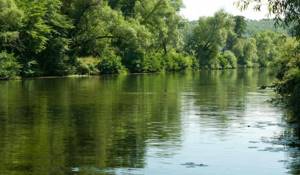
Big Forest and natural park between the Oka and Osetra rivers
We are talking about two of the most gigantic arboretums among those through which the water flow passes. The best sites on the Sturgeon River are recorded in this corner of the riverbed. There is a special nature here - birch, oak, aspen, linden, hazel, rose hips, elderberry. You can also find euonymus. Since 2021, both banks of the Sturgeon between Zaraysk and the mouth have been recognized as specially protected natural areas. The massifs have health trails and equipped descents to the water. They are designed to remind you that the entire floodplain of the reservoir was once wooded... In the ravines along the Osetryk branch there is the same landscape.
Tourism and recreation on the Sturgeon River
The Sturgeon River is located in central Russia, which means that the weather on its banks is shaped by a temperate climate. This means that ideal days are only possible here from the very end of May to mid-September. However, the beginning of the last spring month is a good time to travel by kayak, and September-October is a good time to go picking mushrooms and berries. Sights are mentioned above, but fishing and hunting will be discussed below.
The Sturgeon River is located away from the busiest road routes (the exception is the M-4 toll backup, passing over the wide mouth of Verkusha). At the same time, it is always convenient to get to any episode of its bald floodplain along secondary roads. As a result, sites on the Sturgeon River, as a rule, have an idyllic character... For those who do not like “savagery,” comfortable recreation centers have been built. “Golden sturgeon” on the land of the Osetrovskoye forestry (Venevsky district of the Tula province, 3rd extension of the river). The second will be found even earlier - near the Tula village of Anishino (“Beryozka”), and the third is even closer to the source (BO “Osetrovo” in Burakovo). Tent camping on the Sturgeon River is available at many points. In the middle reaches there is one “but” - you have to go a long way to get firewood. A rare section of the Sturgeon channel has vegetation. It is mainly concentrated in the area of a large birch forest (river “start”), Peskovskaya, Tregubinskaya and Strupinskaya Luka (Moscow region), as well as near the Big Forest (this is beyond Zaraisk).
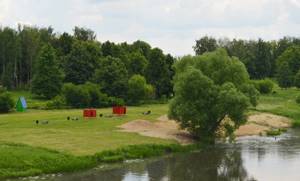
A beach holiday on the Sturgeon River is a matter that requires information preparation. Whirlpools, riffles, lack of depth, litter, awkward relief or “knitting” shore - all this should not spoil your picnic with water treatments. Especially family ones. A swimming holiday on the Osetr River is ideal only in the area of river (natural and man-made) expansions - in the quarry near Melekhovka, in the “sea” near Burakovo and in the wide backwaters near Anishino. In the Osetrovskoe forestry, at the Berezka BO and at Makhrinka. At Esipovo, at Serebryanye Prudy, at Serkovo and at Semenkovo-Perekalya-Livadia. In wooded bends some distance south of Zaraysk (the landscape here is most picturesque). Downstream from Zaraysk - in the narrowing part of the interfluve of the Oka and Osetra (by the way, also very dense). There is a smooth water edge and reach everywhere here. You can drive up.
Rafting on the Sturgeon River also promises a lot of interesting things. The fact is that although the Sturgeon is completely shallow and inconspicuous, it is the only river in the lands of Greater Moscow where there are rifts and riffles, as well as a series of dangerous whirlpools. You will earn yourself an extreme category. Particularly dangerous rafting on the Sturgeon River is possible in the upper reaches and in the middle valley. And the safest is in the area between the settlements of Zaraysk and Berikhino. The second route is the most popular among amateur watermen. Steep slopes, copses with rich deciduous flora, the Church of the Transfiguration - we have already talked about all this in the bottom paragraph of the chapter on attractions. It remains to add about the nature of the kayak stroke. It will be fast. Enough rolls.
Responsibility for illegal fishing
Officially, catching sturgeon on an industrial scale is permitted only in some water bodies in Siberia. Amateur fishing is permitted in almost all regions of our country, but only with a special license, and only on paid reservoirs.
Fish of the sturgeon family are listed in the Red Book, and therefore, in accordance with the legislation of the Russian Federation, for illegal catching of this fish you can incur criminal liability, as well as a fine:
- A fine of 40,000 rubles is imposed for one illegally caught Atlantic sturgeon.
- A fine of 100,000 rubles is imposed for one illegally caught sturgeon in Siberia.
- A fine of 300,000 rubles is imposed for one illegally caught sturgeon during the spawning period.
The nuances of fishing on paid reservoirs:
- The advantage of fishing in reservoirs of this type is that you know for sure that sturgeon are there.
- In order not to be distracted by small fish, you need to choose bait and bait specifically for sturgeon.
- When the weather changes, the sturgeon stops biting, so if a day before the planned fishing the weather begins to deteriorate, then it is better to postpone fishing - there will be no bite.
Fishing and hunting on the Sturgeon River
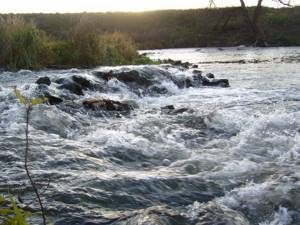
Where the Sturgeon River flows, fishing is inevitable. After all, the reservoir contains such inhabitants as pike, perch, carp, chub, bream, ide, whitefish, silver bream, asp, gudgeon, pike perch, ruff and bleak. Do you want to catch carp or tench? Even so, the Sturgeon River will suit you just fine. Fishing will be a blast at the expansions (the reservoirs listed above and wet areas). And in narrow sections of the river there are reeds, where the main swimming predator likes to hide.
Many fishermen gather near Anishino. There are quite a few of them along all sections of the Venevskoye Highway (Tula-Venev highway). Many fishermen install girders. Blessed point... They say that even the river is full of crayfish. Therefore, fishing for Sturgeon is not the only type of aquatic fishing. But be aware that catching crayfish is prohibited in the Moscow region! So choose rocky shores in the Tula or Ryazan regions... Be more careful with the ichthyofauna from the Red Book. The Sturgeon River is also “inhabited” by some of its representatives. Fishing should not end in an unpleasant conversation with fisheries inspectors. Release the sculpin and sterlet back! From April to June you cannot fish in spawning pits with anything other than a fishing rod. And nets and other cunning devices are not welcome anywhere at all.
Hunting in fields and small parts of forests here promises such prey as black grouse, pheasant, wild goose, duck, wild boar, elk, badger, hare and hare, fox, polecat and bear. Events are held on the territory of official hunting grounds. There are quite a lot of them.
Breeding sturgeon in a pond
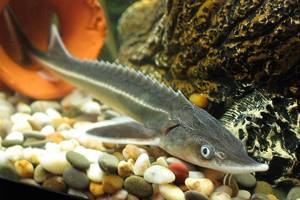
Breeding sturgeon in a pond is a rather complicated process with many nuances, but it is often worth it, because sturgeon is a valuable fish species and the demand for it is always high, even at very high prices. Small sturgeon farms have almost no problems with sales. It will be difficult to achieve success in this matter, because growing sturgeon is a very labor-intensive and complex process. Creating and maintaining the right conditions requires significant investment and effort. Advantages and disadvantages:
- Any sturgeon fish is in high demand in markets and has a high selling price.
- In addition to meat, the skin is offered for sale, which is subjected to special processing for use in various products.
- If good conditions are created, there will be an excess of caviar, which can also be sold, but this will require purchasing special equipment for obtaining caviar and creating special conditions for spawning sturgeon.
- Sturgeons are very picky in terms of nutrition - if there is a lack of certain elements in it, the fish stops growing or stops moving, which will affect its quality. Typically, fry of small freshwater fish and special formulations specifically for feeding sturgeon are suitable for feeding sturgeon. You should always remember that underfeeding and overfeeding fish are equally bad!
- The most difficult period is the growth period of sturgeon - from three to four years, so you should not expect quick money from sturgeon.
If the decision is made, then first you need to arrange a pond. The fact is not critical whether it is an artificial reservoir or a natural one. If a pond already exists, then you need to drain the water from it and clean the bottom mechanically; at the stage of creating a new pond, this is much easier to do. Once the pond is cleaned, it should be planted with plants that are specifically designed for the pond, and the pond should be stocked with shellfish and worms.
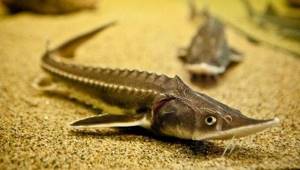
Sturgeon live in an artificial reservoir in the same way as in a natural one, but it is easier to maintain the necessary conditions in it. The temperature at which sturgeon quickly develops varies from fifteen to twenty-four degrees. When the temperature changes, the fish feel good, but grow much slower. With the arrival of winter, the owner is forced to decide where his sturgeon will spend the winter. There are two options - in the pond itself and in a specially prepared pool. In a pond, the sturgeon lies to the bottom, stops growing and feeding, but it is necessary to lim the pond and ensure complete rest for the sturgeon. When placing fish in a pool, it is important to fill it with the required volume, and it is necessary to follow the sturgeon transplantation technology. Be sure to use a container with a five percent salt solution, in which the fish is kept for two to three days, this is done to avoid contamination of the fish in the winter, when it is most susceptible to all kinds of diseases. In addition to sturgeon, breeding sterlet will also be profitable.
Sterlet in the pond has been very popular among consumers for many years, but this is beneficial because the population of sterlet in natural reservoirs has sharply decreased, and fish farms have actively taken the initiative in breeding sterlet. The commercial type of sterlet is considered to be from thirty to sixty-five centimeters in length, and the weight must reach two kilograms.
Breeding and keeping sterlet in a pond requires a closed water supply installation. This is a pool in which the water rotation cycle is closed, thanks to which the water is promptly heated and enriched with oxygen. The temperature favorable for sterlet is from twenty to twenty-one degrees. The purity of water also affects the growth of sterlet. The sterlet will have to be fed with food special for this species. Growing sterlet with caviar will require more effort, and the pond will have to be expanded. For the sterlet, hibernation is necessary, otherwise it will quickly lose all its weight.
Breeding sturgeon and sterlet in a pond, first of all, requires the presence of healthy fry for rearing. You can purchase fry of these fish in our store; all the fish sold here are healthy and well-groomed. You can breed fry yourself, but this requires additional financial costs and time.
In general, raising sturgeon and sturgeon fish is a labor-intensive hobby. By the time the first sturgeon reach commercial size, all costs will slowly begin to pay off through their sale. You should always know that fish is highly valued among consumers.
Protection of the Sturgeon River
The protection of the Sturgeon River takes place in its lower reaches (within the boundaries of the biosphere reserve), in areas of the Zaraisky urban district of the Moscow region, as well as the Yasnogorsky and Venevsky districts of the Tula region. The riverbed is clearing. Voluntary cleanup days are held. There is an environmental inspection on the ground, patrolling favorite picnic spots... The protection of the Osetr River within the Ryazan region has signs limiting the access of cars (the area of the Livadia Reservoir). In the upper reaches (Yasnogorsk district of the Tula region), the protection of the Sturgeon River is poorly thought out. The water quarry near Burakovo was occupied by irresponsible citizens who left a lot of rubbish.
I would like to believe that the description of the Sturgeon River will encourage you to collect a kayak or a raft that is dusty in the garage. However, these shores are also explored with the help of a car. You get the idea: the unique waterway is a route for different types of fish. There are many animals around it that are officially allowed to be shot. There are also mushrooms here. But most of all, it is the natural beauty and silence for a relaxing family holiday.
What to do with caught fish
Freshly caught fish can be immediately cooked over a fire after setting up camp. Like any food, lake sturgeon in rdr 2 online. How can you improve your health in RDR 2 online? After cooking, it can be stored in a bag.
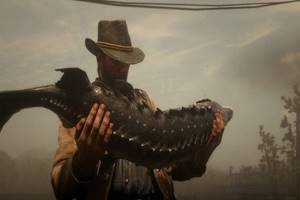
Legendary fish - lake sturgeon in the game Red Dead Online
Or you can sell fresh fish at a butcher shop. You can find one in almost every settlement. Depending on the weight, you can get from 3 to 8 dollars for sturgeon. It is not recommended to carry fresh fish on the back of a horse for a long time, otherwise you risk soon being left with a rotten carcass that no merchant will be interested in.
If you decide to cook your trophy, then in addition to primitive frying over a fire, we recommend adding spices to the fish. The use of spices in cooking affects the number of units of a particular parameter (stamina, health, dead eye) restored.
Here is a list of spices with which you can cook lake sturgeon to give the fish special properties:
- Mint;
- Oregano;
- Creeping thyme.
